NVIDIA's GeForce GTX 560 Ti: Upsetting The $250 Market
by Ryan Smith on January 25, 2011 9:00 AM ESTCompute & Tessellation
Moving on from our look at gaming performance, we have our customary look at compute performance, bundled with a look at theoretical tessellation performance. Unlike our gaming benchmarks where NVIDIA’s architectural differences between GF114 and GF110 are largely irrelevant, they can become much more important under a compute-bound situation depending on just how much ILP can be extracted for the GTX 560 Ti.
Our first compute benchmark comes from Civilization V, which uses DirectCompute to decompress textures on the fly. Civ V includes a sub-benchmark that exclusively tests the speed of their texture decompression algorithm by repeatedly decompressing the textures required for one of the game’s leader scenes.
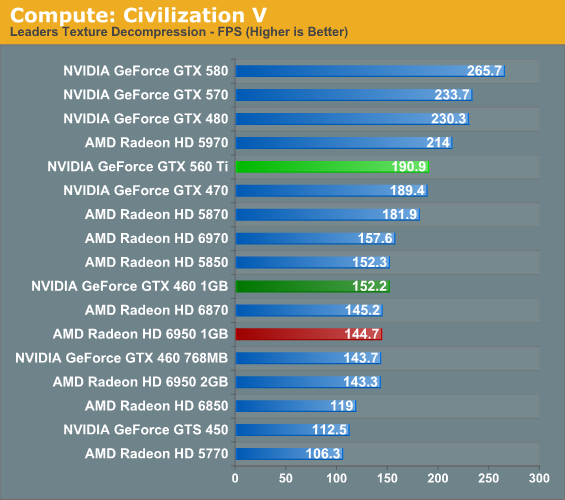
Under our Civilization 5 compute benchmark we have a couple of different things going on even when we just look at the NVIDIA cards. Compared to the GTX 460 1GB, the GTX 560 enjoys a 31% performance advantage; this is less than the theoretical maximum of 39%, but not far off from the performance advantages we’ve seen in most games. Meanwhile the GTX 470 is practically tied with the GTX 560 even though on paper the GTX 560 has around a 15% theoretical performance advantage. This ends up being a solid case of where the limitations of ILP come in to play, as clearly the GTX 560 isn’t maximizing the use of its superscalar shaders. Or to put it another way, it’s an example as to why NVIDIA isn’t using a superscalar design on their Tesla products.
Meanwhile this benchmark has always favored NVIDIA’s architectures, so in comparison to AMD’s cards there’s little to be surprised about. The GTX 560 Ti is well in the lead, with the only AMD card it can’t pass being the dual-GPU 5970.
Our second GPU compute benchmark is SmallLuxGPU, the GPU ray tracing branch of the open source LuxRender renderer. While it’s still in beta, SmallLuxGPU recently hit a milestone by implementing a complete ray tracing engine in OpenCL, allowing them to fully offload the process to the GPU. It’s this ray tracing engine we’re testing.
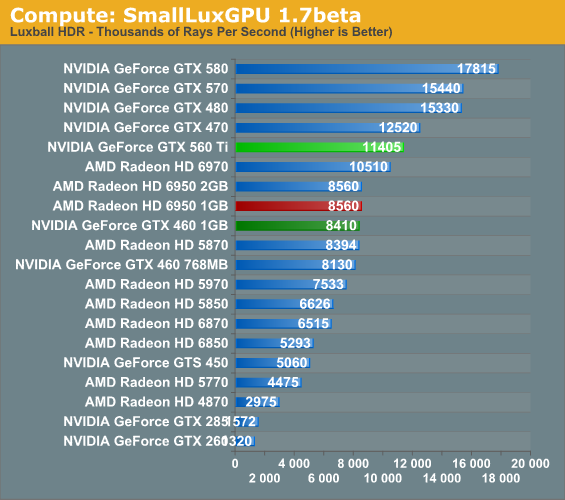
Small Lux GPU is the other test in our suite where NVIDIA’s drivers significantly revised our numbers. Where this test previously favored raw theoretical performance, giving the vector-based Radeons an advantage, NVIDIA has now shot well ahead. Given the rough state of both AMD and NVIDIA’s OpenCL drivers, we’re attributing this to bug fixes or possibly enhancements in NVIDIA’s OpenCL driver, with the former seeming particularly likely. However NVIDIA is not alone when it comes to driver fixes, and AMD has seem a similar uptick against the newly released 6900 series. It’s not nearly the leap NVIDIA saw, but it’s good for around 25%-30% more rays/second under SLG. This appears to be accountable to further refinement of AMD’s VLIW4 shader compiler, which as we have previously mentioned stands to gain a good deal of performance as AMD works on optimizing it.
So where does SLG stack up after the latest driver enhancements? With NVIDIA’s rocket to the top, they’re now easily dominating this benchmark. The GTX 560 Ti is now slightly ahead of the 6970, never mind the 6950 1GB where it has a 33% lead. Rather than being a benchmark that showed the advantage of having lots of theoretical compute performance, this is now a benchmark that seems to favor NVIDIA’s compute-inspired architecture.
Our final compute benchmark is a Folding @ Home benchmark. Given NVIDIA’s focus on compute for Fermi, cards such as the GTX 560 Ti can be particularly interesting for distributed computing enthusiasts, who are usually looking for a compute card first and a gaming card second.
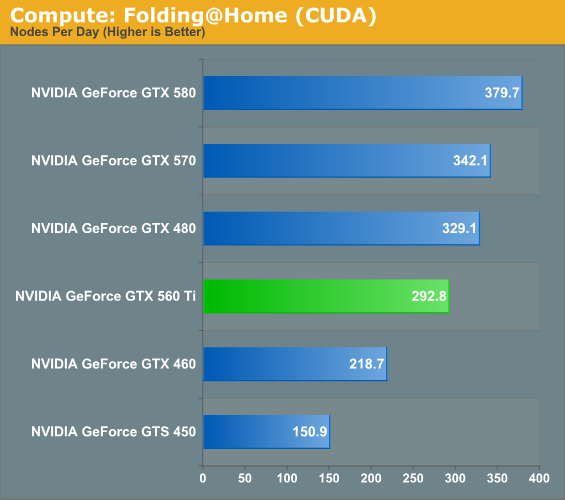
Against the senior members of the GTX 500 series and even the GTX 480 the GTX 560 Ti is still well behind, but at the same time Folding @ Home does not look like it significantly penalizes GTX 560’s superscalar architecture.
At the other end of the spectrum from GPU computing performance is GPU tessellation performance, used exclusively for graphical purposes. With Fermi NVIDIA bet heavily on tessellation, and as a result they do very well at very high tessellation factors. With 2 GPCs the GTX 560 Ti can retire 2 triangles/clock, the same rate as the Radeon HD 6900 series, so this should be a good opportunity to look at theoretical architectural performance versus actual performance.
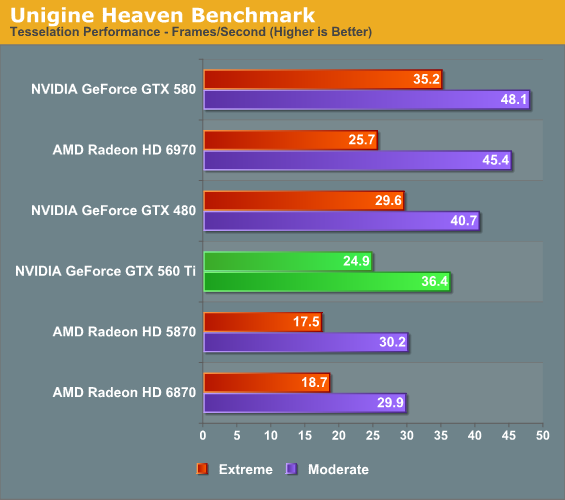
Against the AMD 5800 and 6800 series, the GTX 560 enjoys a solid advantage, as it’s able to retire twice as many triangles per clock as either architecture. And while it falls to both GTX 480 and GTX 580, the otherwise faster Radeon HD 6970 is close at times – at moderate tessellation it has quite the lead, but the two are neck-and-neck at extreme tessellation where triangle throughput and the ability to efficiently handle high tessellation factors counts for everything. Though since Heaven is a synthetic benchmark at the moment (the DX11 engine isn’t currently used in any games) we’re less concerned with performance relative to AMD’s cards and more concerned with performance relative to the other NVIDIA cards.
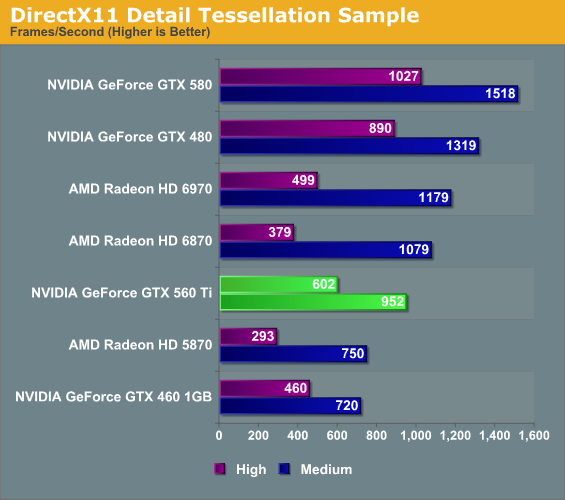
Microsoft’s Detail Tessellation sample program showcases NVIDIA’s bet on tessellation performance even more clearly. NVIDIA needs very high tessellation factors to shine compared to AMD’s cards. Meanwhile against the GTX 460 1GB our gains are a bit more muted; even though this is almost strictly a theoretical test, the GTX 560 only gains 30% on the GTX 460. Ultimately while the additional SM unlocks another tessellator on NVIDIA’s hardware, it does not unlock a higher triangle throughput rate, which is dictated by the GPCs.










87 Comments
View All Comments
surt - Tuesday, January 25, 2011 - link
It doesn't work like that. Computer games generally have no more than 3 frames rendered at a time. The remainder is pre-render textures, models, etc ... everything that might be needed to render a frame. They need to have everything handy that might be needed to make a picture of your view-point. Any enemy that might step into view. The mountains behind you in case you turn around, etc. If it isn't already stored on the card, they have to go get it from disk, which is comparatively extremely slow (thousands of times slower than anything that is already in memory).ATOmega - Tuesday, January 25, 2011 - link
Okay, so it's released today. Where are they? I can't find one at local stores and they don't even know when they're getting them in.MrJim - Tuesday, January 25, 2011 - link
Full bitstreaming audio capabilities? Thinking about this card and Adobe Premiere CUDA-hack :)heflys - Tuesday, January 25, 2011 - link
The 560 is only faster when you feature games that show a bias towards Nvidia products. Heck, in some of those tests, it was beating a 6970!Lolimaster - Tuesday, January 25, 2011 - link
And know you can adjust that absurd tessellation levels(that no one notices) with 11.1a hotfix.560 is unimpressive, without much effort 6870 1GB / 6950 1GB are taking the bang for buck crown. Specially 6870 at near $200.
If you want futureproof don't look back, 6950 2GB all the way.
cknobman - Tuesday, January 25, 2011 - link
thats exactly what I was thinking.heflys - Tuesday, January 25, 2011 - link
I just don't see how a game like HAWX, with its history, can be a indicator of the 560 being faster.Sufo - Wednesday, January 26, 2011 - link
Yeah, i have to agree here. In the the two games generally considered the most taxing of modern systems (crysis and metro) the 6950 comes out on top (by like 15% at that) - i think it's a mistake to say:"The GTX 560 Ti ultimately has the edge: it’s a bit faster and it’s quieter than the 6950, and if that’s all you care about then there’s the answer you seek."
I haven't totted it up but even if the 560 over all benches has a few frames over the 6950 (tho tbh, it doesn't even look that way :/) the fact that it loses in games like this means people buying it on that recommendation, thinking it's the faster card, will be disappointed.
murray13 - Tuesday, January 25, 2011 - link
I just don't get your conclusion. You say that the 560 is faster than the 6950 1g but looking at the graphs it's a draw. It's faster is some games the AMD is faster in others.I originally just looked at the games I play and when I did that the 6950 won all of them. It's a good thing I went back and looked at all of them before I posted. I was ready to really give it to ya. But as it is I just think these two cards are about as evenly matched both in performance and price as I've seen from the two camps in a long time.
Running a 8800GTX I'm about due for a gfx card upgrade. With what is out right now the 6970 is about the best bang for my buck.
Ever since Anand stopped doing the vid card reviews (yeah it's been a while) I haven't exactly agreed with the conclusions being given. Everyone's entitled to theirs I guess.
vol7ron - Tuesday, January 25, 2011 - link
I'm still on the E6600 C2D with a 9800GTX - the next upgrade is going to be crucial. It all hinges on that Z68 chipset.We've been looking at i7-2G for our workstations as well. I don't think we're considering the Z68 for that, since it's not necessary and the P67 is a good capable board.
All-in-all; personal upgrade is still on schedule (sometime around 2011Q2-2012Q2), hinging on Z68 and SSD releases.